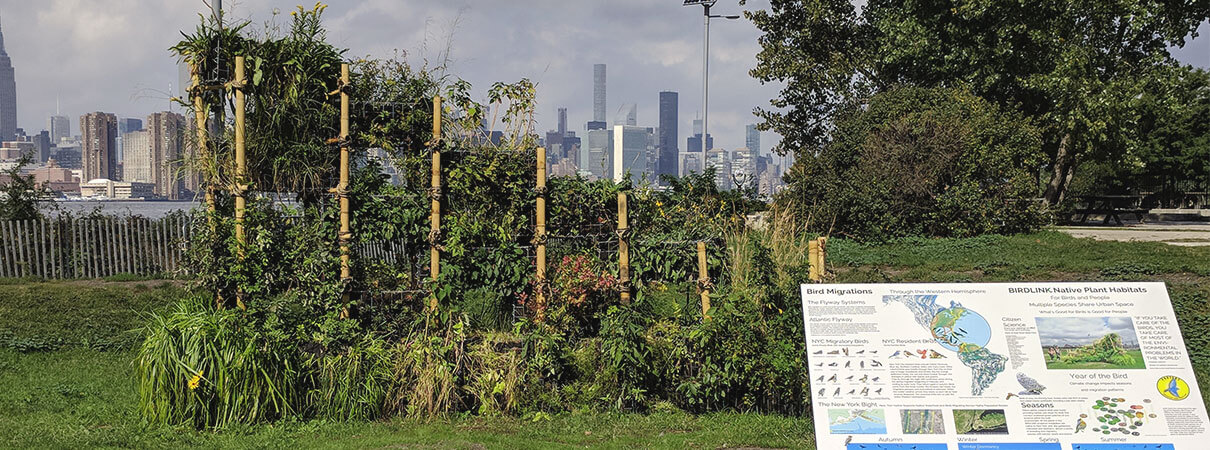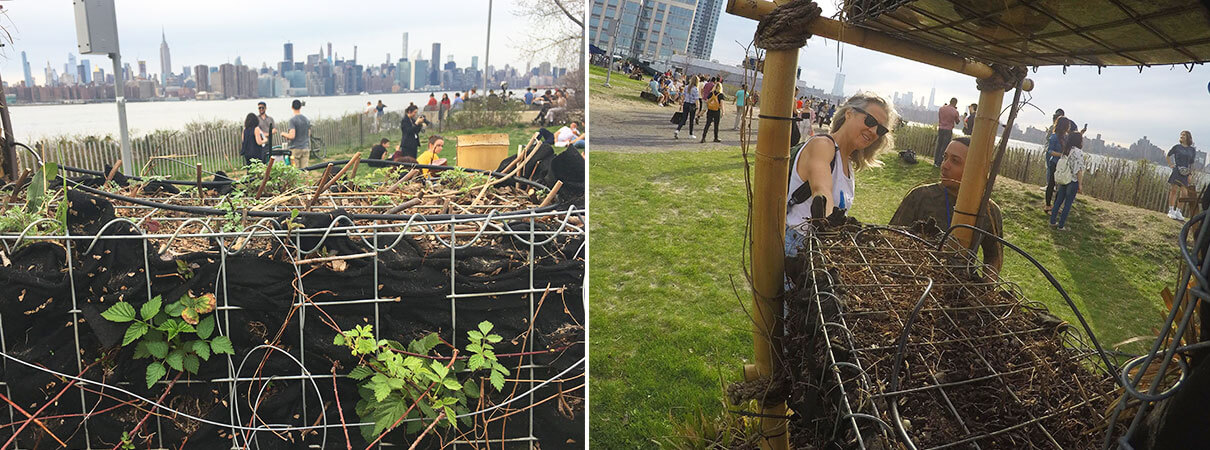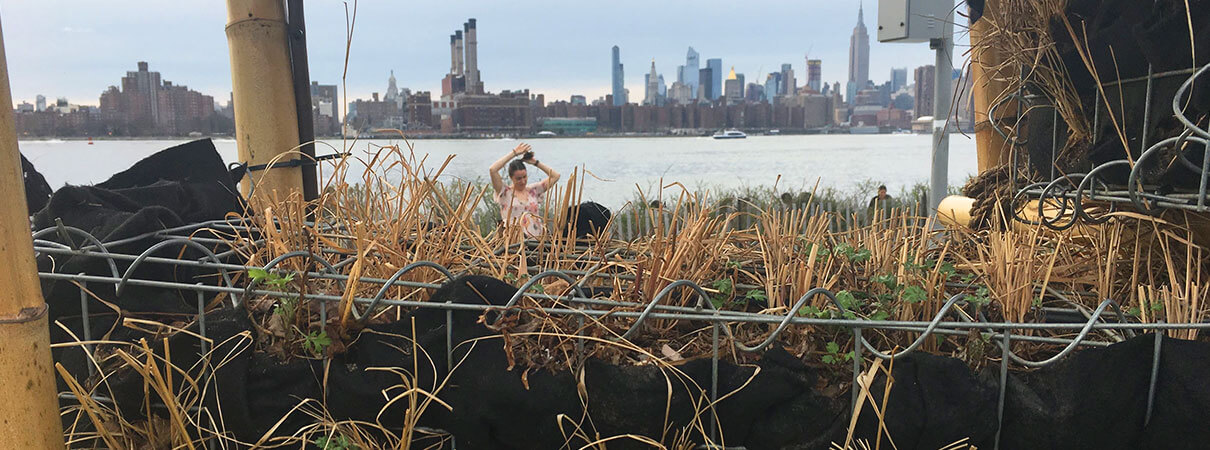This Art Project Could Help Make Cities More Habitable for Birds
Can a series of art installations in New York City raise awareness about bird migration while improving urban habitat for migratory birds?
Resembling a bushy staircase at first glance, the living sculpture at East River State Park in Brooklyn may draw incredulous looks from curious park-goers, but for migratory birds, the structure — bursting with plants rich with berries, seeds, and flowers — is a much-needed commodity in a sea of concrete and asphalt.
Anina Gerchick, the New York-based artist and landscape architect behind this project, aims both to elicit reactions from passersby and to benefit wildlife. She designed BIRDLINK to be a green space particularly for birds that would also help connect city dwellers with the natural world.

BIRDLINK installation at East River State Park in New York City. Photo courtesy of Anina Gerchick
Employing bamboo poles to vertically stack a row of felt-lined plant beds, Gerchick's structure offers maximum benefits to winged visitors in a limited space. The sculpture is meant to be easily replicable, and is designed for both permanent or semi-permanent use, depending on need.
When it comes to birds, there's little question that BIRDLINK's blooming arms, which hold everything from juniper to black raspberry, have much to offer. And with spring migration along the Atlantic Flyway underway, migratory birds like the Yellow Warbler and Purple Finch are already reaping the fruits of this project.
Gerchick hopes that they aren't the only ones that find it valuable. Ultimately, she wants BIRDLINK to start conversations among those who typically don't think about these issues, raising awareness about bird conservation.
Making this happen, Gerchick believes, is a question of location. Her dream venue is one of New York City's highly visible, heavily visited city parks. To this end, Gerchick designed BIRDLINK to be adaptable for a variety of sites, building the structure with low-cost, reusable materials, and adopting a watering system fed by nearby fire hydrants.
Installing BIRDLINK in one of New York's popular city parks, however, has proven elusive. The two locations that have hosted BIRDLINK sculptures thus far, Governor's Island in New York Harbor and now East River State Park, are both larger, more open settings than Gerchick originally imagined.
But that's about to change as BIRDLINK comes full circle.

Left: BIRDLINK's plant stations are constructed with felt sacks and metal caging. Right: Gerchick explains BIRDLINK. Photo courtesy of Anina Gerchick
BIRDLINK's Beginning
The idea for the project came to Gerchick while watching wild birds and caged songbirds interact at the Hua Mei Bird Garden, which is located within Sara D. Roosevelt Park on Manhattan's Lower East Side. “Neighbors bring their pet songbirds in cages to this garden, and hang them there to sing,” she says. “I saw that wild birds would fly around those birds singing in the cages.”
Their interactions within the city's largely artificial, urban setting got Gerchick thinking and she began to wonder how her artwork could support urban birds and encourage their conservation.
It's no secret that city parks play an important role for birds — even when they're designed without birds and bird habitat in mind. How much more beneficial could they be with the addition of specifically designed bird habitat?
That question will be answered where the idea began, at Sara D. Roosevelt Park, on June 8, when the park becomes BIRDLINK's third placement site. Thanks to public and private funding, and a Burke Center for Native Plants grant, BIRDLINK will be installed facing the park's busiest street.
“The impact will be what we are looking for,” says Gerchick. The park, which is located in a dense, ethnically and economically diverse residential neighborhood, will provide BIRDLINK with a wide audience including city residents and tourists frequenting the area. And, not least important, birds in the park will enjoy improved habitat.
Placing BIRDLINK in such a heavily trafficked site will mean more questions, more interest, and more effort, but Gerchick is not working alone. New York City Audubon is a fiscal sponsor for the project and will monitor bird interactions with the sculpture during its six-month placement. Plus, local organizations such as Urban Park Rangers and Explore Birds Program will provide interpretive programs and materials.

Spring grasses begin to awaken earlier this year at the BIRDLINK East River State Park installation. Photo courtesy of Anina Gerchick
A Growing Future
The new placement is sure to provide BIRDLINK with added visibility and new momentum. Gerchick has sites in the works in other states, including Georgia and Indiana.
Meanwhile, Gerchick is hard at work tweaking BIRDLINK, adding structural flexibility and developing an irrigation system that captures rainwater or water that would otherwise be wasted.
With improvements underway, public exposure expanding, and future installations planned, it's becoming easier to imagine a day when BIRDLINK will occupy a variety of urban areas, gracing city parks with its verdant, bird-friendly habitat.
BIRDLINK sponsors include: EPA's "Connect Kids to Parks" program, the Coleman and Susan Burke Center for Native Plants, National Audubon, and New York City Audubon.





































 Bryony Angell writes and birds from western Washington State. Birding culture is her beat; read more of her work at
Bryony Angell writes and birds from western Washington State. Birding culture is her beat; read more of her work at 












